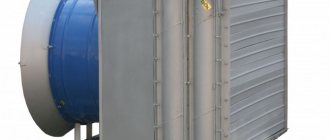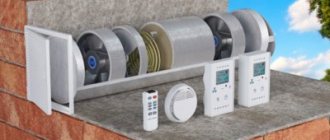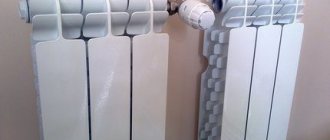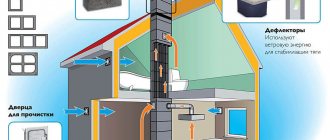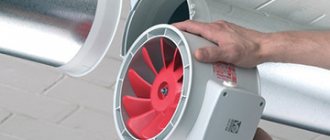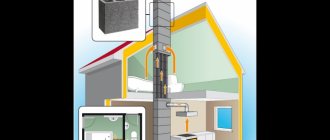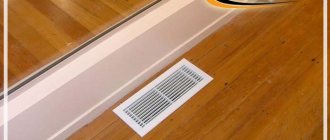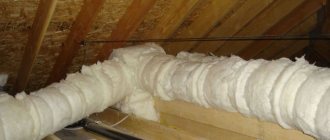Home / Ventilation /
In this article I will tell you why 90% of private swimming pools do NOT need recuperators and dehumidifiers. I will explain the most effective and simple pool ventilation scheme, tell you how it works, analyze the equipment and how to properly organize air exchange.
Good afternoon My name is Alexey Goltsov . I'm a design engineer. Every month I release 3-4 ventilation projects for swimming pools.
I mainly work in Moscow and the Moscow region.
I do not scam the Customer into expensive recuperators and dryers. 100% of private pools do not need them. I design and calculate the simplest and most effective ventilation system.
Most of my projects go straight into editing, because... The cost of the work is given to you not by the company, but by my installer Andrey, who will assemble the system himself without intermediaries.
How much does pool ventilation cost?
How do companies deceive pool customers?
Often customers send me projects from other companies for review. I find mistakes, write recommendations and treat this with understanding: people made mistakes, we need to correct them and move on.
It’s a completely different matter when I receive a project from a large organization. There are no mistakes in such projects. Everything was done correctly, but the Customer was scammed out of millions of rubles! How it works:
Air Dryer
As soon as you say the word “pool”, you will immediately be offered dehumidifiers. This is the standard operating procedure. But you need to understand:
Dehumidifiers are used either in small leisure areas with a plunge pool or in large commercial swimming pools.
In private swimming pools, a dehumidifier is used with a water surface of up to 14 m2 only to reduce the load on the ventilation system. Simply put, to reduce the size of ventilation equipment and air ducts. A pool dehumidifier is never used as the main equipment.
If you see a dehumidifier in the pool, someone has successfully made money on the customer’s ignorance.
Read more: The dehumidifier does not remove odors or provide fresh air. To dry a small pool of 15 m2 you will need the most powerful dehumidifier for 350,000 rubles. In summer and winter it works at the same power, although in winter the air outside is very dry. Manufacturers artificially increase the power of dehumidifiers by 40%, and in reality the dehumidifier cannot cope with the volume of moisture. More details in this article.
Dehumidifiers are not used in private swimming pools.
Air handling units with dehumidification section
Such installations are offered by both installation and design companies. Such installations cost from 800,000 rubles and are not used in private swimming pools.
They can be offered in 3 cases:
- Your pool with a water surface of more than 80 m2;
- Swimming pool in a humid climate zone (for example, Sochi);
- They are trying to deceive you.
There are no other explanations and cannot be. A dehumidification section is only needed if the outside air has much worse parameters than the air in the pool. For example, in Sochi the air is so humid that it cannot be used to ventilate the pool, so it is easier to install a dehumidifier.
Heat recovery plants
This is another scam of customers out of money. Installations with recuperators are very expensive and are used only on commercial swimming pools. A recuperator is needed to save thermal energy in winter, but its use in private swimming pools is not economically justified.
In winter, the air outside is very dry. To drain a pool, you need 7 times less water than in summer. So, for example, in a pool with a water surface of 40 m2 in winter, approximately 700 m3/h of air is needed.
Such a volume of air is tiny to justify installing a recuperator. The equipment will never recoup its investment also because 700 m3/h is required for the pool only in operating mode when people are swimming. To reduce evaporation, private pools are covered with a screen - an awning, so during the winter month only 200 m3/h is supplied to the room.
As a result, the air in winter is dry. Little is required. The pool is covered with a screen most of the time, so the installation with a recuperator sits idle.
Conclusion The interests of builders do not coincide with the interests of the customer. The builder wants to make money on the equipment, so he offers “some” expensive technical solution.
To compare costs, the customer goes to other companies and, as a result of communication, receives completely different commercial offers and is completely confused about the effectiveness of the proposed systems.
If you have received an estimate for a swimming pool ventilation system for 1.5 million rubles, there is reason to think about it. Most likely, they are trying to deceive you.
If you don't want to read the article, you can watch my video on this topic.
Air environment in the pool: optimal parameters
Ventilation of an indoor pool must maintain standard air parameters in it:
- temperature,
- humidity,
- fresh air supply,
- air mobility.
Temperature
should be comfortable. In relation to an indoor pool, a distinction is made between water and air temperature regimes. The rule here is: the air temperature should be 2o C higher than the water temperature. This is required for comfortable swimming and staying in the pool. In addition, in a situation where the water temperature exceeds the air temperature, the formation of condensation increases. Optimal temperature parameters: water - 24-28 o C, air - 26-30 o C. Electric heaters are used to maintain optimal water temperature.
Humidity
- the main parameter, the regulation of which is directly related to maintaining the pool structure and its finishing in optimal condition. In relation to the pool ventilation system, they operate not with absolute, but with relative humidity, which shows the degree of saturation of water vapor and the possibility of its transition into water condensate.
The humidity in a room with a swimming pool is extremely dependent on the ambient temperature: a decrease in temperature by 1°C increases the relative humidity by 3-3.5°C. Recommended humidity parameters depend on the time of year. Since there are no cold surfaces in the pool room during warm summers, the risk of condensation is reduced. In winter, due to the contrast between water and room temperatures, a significant increase in humidity is possible. In summer, the relative humidity in an indoor pool can reach 65%, but the maximum permissible value in winter is 45-50%. To maintain a comfortable relative humidity, it is recommended to cover the pool outside of use.
Fresh air supply
regulated by sanitary standards. For one person it is 80m3/h. The supply of fresh air in an indoor pool also requires special work, because without being ventilated, the room with the pool is deprived of natural air circulation.
Air mobility
ensures the absence of so-called stagnant zones in the room, in which condensation settles even if optimal humidity parameters are observed. Air mobility must be ensured in such a way that its flows do not create a through wind over the bathing area. Drafts above the pool bowl not only reduce the comfort of staying in the water, but also increase the evaporation of the latter.
When is a ventilation system needed in a swimming pool?
Ventilation in the pool solves 3 problems: supplies air for breathing, removes moisture and odors. A dehumidifier only removes moisture, leaving the air stale. But:
A dehumidifier for a pool with a 15 m2 mirror will cost less than ventilation. It's all about the starting price. The initial cost of any adequate ventilation system is 300 thousand rubles. "Full construction". A dehumidifier for a 15 m2 pool - the same Danvex DEH-600 - will cost less - 170 thousand rubles. Profitable!
Ventilation in a pool with a water surface larger than 15 m2 is cheaper and more effective than a dehumidifier. If the water surface is less than 15 m2, install a dehumidifier.
How to get rid of high humidity
A good ventilation system in a swimming pool is extremely important because it, first of all, solves the problem of excess moisture in a closed room, which appears due to the evaporation of water from the font. Humidity is also formed from evaporation from the human body, wet floors, towels and other objects.
You can combat excess humidity in a building with a swimming pool by covering the bowl while no one is swimming, but during swimming the air will still be oversaturated with moisture. Therefore, it is necessary to properly equip an efficiently operating dehumidification system using special equipment, since ineffective ventilation will lead to premature destruction of the room.
Air dehumidifiers are an essential element of the ventilation system in a swimming pool to combat high humidity. When choosing a device, first of all, take into account the volume of the building, because in one hour of operation the dehumidifier must pass through itself the entire volume of air from the room three times.
The most popular are devices located on the wall. However, they work exclusively to destroy excessive moisture. From a functional point of view, duct installations are more efficient, since in addition to the main task they provide an influx of fresh air. But the best option is a supply and exhaust system with integrated dehumidifiers.
You can do without a drying device only if:
- within an hour, air masses are completely renewed naturally at least three times;
- the pool is used extremely rarely and not for long;
- the water mirror does not exceed 10 square meters in size;
- During downtime, the bowl is always covered with a special coating that prevents evaporation.
Special blinds for covering the water surface significantly reduce electricity costs and equipment wear.
How to remove moisture by ventilation? Principle of operation
In the summer, when the air outside is humid, we simply blow through the pool room with an increased volume of air. For these purposes we use separate supply and exhaust units.
In winter, when the air outside is cold and dry, we simply heat it in the air handling unit and supply it to the pool. We direct the supply jets to the water surface for maximum moisture absorption.
We suspend the supply and exhaust units from the ceiling of the garage or in any other technical room. We install a network of air ducts under the ceiling of the pool, through which we remove the moist air to the street.
In winter, 7 times less air is required to drain the pool than in summer. The supply unit operates at a minimum in winter, so no recuperators are needed.
Thus, ventilation units for swimming pools operate in 2 modes - summer and winter.
Summer. The air outside is warm and humid, so it is supplied to the pool room without heating. The moisture content in summer is very high - 12.8 g/kg. Therefore, in order to remove moisture from the pool with already humid street air, it is necessary to blow through the pool room with a large volume of air, i.e. take not by quality, but by quantity.
Winter. The situation is the opposite. The air outside is cold and needs to be heated to supply it to the pool. But the main thing is that it is very dry. Its moisture content is only 0.39 g/kg, i.e. In winter, the air is 32 times drier than in summer , which means that much less volume of such air is needed.
For example, to dehumidify the air in a pool with a water surface of 25 m2, approximately 3000 m3/h of air is needed in summer, and only 400 m3/h in winter, which is 7.5 times less.
Supply ventilation of swimming pools
To create the necessary air conditions in the pool room, supply ventilation must be organized. The solution to this issue is carried out by a ventilation unit that sucks in outside air from the street and pre-cleans it from various mechanical impurities. Then, depending on the cold or warm period of the year or region, the air is heated or cooled. Only after such treatment the air is directed and distributed throughout the room by means of a fan. The most suitable equipment for this purpose is the VEZA VEROSA supply ventilation units (floor-mounted) or VEZA AIRMATE (suspended version). The units have an insulated body and are manufactured using modern equipment and modern technologies.
When organizing only supply ventilation in the pool, we are faced with the following problem - where to put the air that is supplied to the room? After all, it is logical that it should be removed from there in exactly the same way as it entered the premises. Basically, air has several paths, and these are:
- squeezing air, under the pressure of a supply fan, from the room through the cracks of doors and windows. However, you should expect that a strong whistle from the air being squeezed out will be heard in the doors and windows, and they will open/close with some difficulty. Let's do some math - let's assume that the air exchange rate is on average about 5 units. The volume of the room is, for example, 200 m3. Total air exchange is 200 m3 • 5 h-1 = 1000 m3/h. A standard door has dimensions of 2000 mm x 800 mm. Let's assume that the gap under the door is 1 cm high. In total, the gap area will be 0.8 m • 0.01 m = 0.008 m2. The air speed in such a doorway, with the calculated air exchange, will be 1000 m3/h ÷ 3600 ÷ 0.008 m2 = 34.7 m/s. Such a high air velocity in the gap will definitely cause a lot of noise;
- squeezing air, under the pressure of a supply fan, from the room through open window openings. If in the summer this decision may be acceptable, then in the cold season such a choice may seem at least strange;
- squeezing air, under the pressure of a supply fan, from the room through pre-designed natural ventilation channels. In this case, removal occurs through embedded shafts, but in this case it becomes more difficult to regulate the volume of air removed, and it should also be understood that through these channels the air will be removed in the same way as through cracks and leaks in door and window openings;
- removal of exhaust air from the room due to mechanical exhaust. In this case, in the room, along with supply channels and air supply nozzles, there are also exhaust air channels with their own set of air intake holes. Air is extracted through the operation of an exhaust fan.
How much does it cost to turnkey a swimming pool?
The company is given different prices. The table below shows the optimal prices for the market. I am a designer and I make money from designing. I post prices not for the purpose of putting pressure on installation companies, but so that my Customers understand the pricing and do not faint.
Unlike dehumidifiers, the cost of ventilation equipment practically does not depend on the size of the pool. The main price tag is the extensiveness of the air duct network and the cost of installation work.
| Water surface area | |||||
| Price | 15 m2 | 21 m2 | 28 m2 | 35 m2 | 40 m2 |
| Equipment | 180 thousand rubles | 350 thousand rubles | 365 thousand rubles | 400 thousand rubles | 570 thousand rubles |
| Materials | 110 thousand rubles | 100 thousand rubles | 160 thousand rubles | 180 thousand rubles | 200 thousand rubles |
| Works | 70 thousand rubles | 120 thousand rubles | 140 thousand rubles | 140 thousand rubles | 150 thousand rubles |
| Total | 370 thousand rubles | 570 thousand rubles | 670 thousand rubles | 720 thousand rubles | 920 thousand rubles |
There are more than 20 brands of ventilation equipment on the market with different pricing policies. The table shows the simplest and most effective pool ventilation system based on NED and Breezart equipment. Without a project, you cannot be sure of the correctness of decisions, and installers will not be able to assemble the system.
The cost of the project is from 35,000 to 50,000 rubles.
Comparison with dehumidifiers: yes, in some cases a dehumidifier will be cheaper than ventilation. For example, in pools with a water surface of 25 m2, the dehumidifier is 20% cheaper. But when installing a dehumidifier, you will in any case have to install a simple ventilation system for basic ventilation of the room.
As a result, a combined ventilation and dehumidification system will be much more expensive than full ventilation designed to remove moisture. In pools with a mirror of 35 m2 or more, the cost of the dehumidifier and ventilation is the same, but the functionality of the dehumidifier is much less.
Moisture assimilation
In the search for effective ventilation systems in the pool, schemes and structural designs, one cannot ignore the method of moisture assimilation in the pool. It involves using the natural property of air to absorb water vapor. The technology allows for 5-fold air exchange in one hour of operation.
In temperate latitudes and in houses with small swimming pools, a conventional ventilation system is sufficient. But if we are talking about large water tanks in gyms and entertainment complexes, then here it is necessary to additionally equip a multifunctional dehumidifier.
An undeniable advantage of moisture assimilation is the effective elimination of unpleasant odors that appear due to high humidity. As for the minuses, there are few of them. The most unpleasant moment is the dependence on weather conditions, because if the surrounding air is too humidified, it will not be able to absorb condensation from the room with the pool.
But in most cases, this scheme justifies itself and outperforms other solutions. Another disadvantage of assimilation is the need to warm up the supply air. The procedure is especially necessary during cold periods, when the heating process requires a lot of electricity.
Engineers also practice a combined pool drainage method, which is in demand for large areas and pools with a high frequency of visits. In this case, you have to combine a dehumidifier and a forced ventilation system.
In this case, the type of equipment can be independent or form an irreplaceable part of the overall system that affects the microclimate. Combined options are expensive options and are justified only on an area of 50 square meters or more.
Air exchange rates in the pool
Main standard for swimming pools SP 310.1325800.2017
Let me consider the most important requirements:
1. Indoors need to be maintained at 30 °C all year round , because... people walk around undressed, so the supply air temperature is calculated not at 23 oC, as in ordinary rooms, but at 30 oC.
2. Relative air humidity no more than 55-65%. In pools in wooden houses, air humidity should be no more than 45%. A change in humidity by at least 5% requires a change in air volumes by 35%, so humidity is the most important indicator for calculating pool ventilation.
3. Air mobility 0.2 m/s. Therefore, the pool always has very large ventilation grilles. The speed of the grates should be minimal so that people do not catch a cold.
4. There are more exhausts than inflows. In pool rooms, the volume of supply air is 10% greater than the volume of exhaust air. This is done to prevent moist air from escaping into adjacent rooms.
Project calculation
The calculation is made using special formulas that will allow you to determine the air exchange rate and other key indicators in a specific situation.
In addition to the above indicators, you should take into account the level of heat and moisture from bathing people, solar exposure, and the surface of the water itself.
Calculation of pool ventilation:
1. Formula for determining air exchange. W=e×F×Pb – PL , where: • e – evaporation coefficient; • F – total size of the water surface (in square meters); • Pb – level of water vapor pressure in air saturated with moisture at a given temperature (in bars) • PL – level of water vapor pressure taking into account the given temperature and desired humidity (in bars).
2. Formula for determining the air flow rate. By mass: mL=GW×XB – XN , By volume: L=GWr×XB – XN , where: • GW – total volume of moisture evaporation in the room (grams per hour); • XB – moisture level in the room with a swimming pool (grams per kilogram); • XN – moisture level outside the room with a swimming pool (grams per kilogram); • r – air density at the desired temperature (kilogram per cubic meter)
During the subsequent installation of a moisture and air removal system, these indicators are taken into account - this makes it possible to increase the wear resistance of the entire house and reduce operating costs.
Air exchange rate in the pool
I am constantly asked about the frequency of air exchange. But in swimming pools there can be no concept of “multiplicity”.
The multiplicity is based on the volume of the room. In pool ventilation, the volume of the room does not play any role. The room can be large, but the pool is very small and vice versa. We are not interested in volume, but in the area of the water surface. Therefore, quickly calculating the installation “on your knees” by multiplicity and giving the Customer the correct option is a bad idea.
You need to take into account additional equipment: geysers, fountains, countercurrents. They change the notorious “air exchange rate”.
To correctly calculate air volumes, you can use the ABOK method or a specialized program (https://www.softhvac.ru/ventilacia-bassejna)
If we empirically translate the results into a multiplicity, it turns out from 6 to 15 in the summer.
DIY pool ventilation: sequence of work
Before designing, it is necessary to compare several technological solutions
- First, we start with the selection of equipment that will be built into the ventilation scheme.
- Secondly, we calculate the cross-section of the pipes, which is important for proper air supply and exhaust.
- Thirdly, we place the inflow and exhaust pipes. Since moist and warm air rises, we place the hood near the ceiling. According to all the rules for constructing a system, the inflow pipe must be placed in the lower part of the room. But in the pool, this position will create discomfort. Therefore, this is structurally solved this way: the entrance to the room is located at the bottom, then it is pumped upward through a duct, where pipes with ventilation grilles are located along the entire perimeter of the room, through which fresh air is supplied. For a good rate of recirculation of air masses, large grates are installed.
- Fourthly, to maintain good air exchange, a deflector is installed at the end of the exhaust pipe, sucking in the exhaust moist air and releasing it into the atmosphere through special channels.
- Fifthly, it is advisable to provide a device that is not part of the ventilation system, but greatly facilitates its work. These are special blinds that cover the pool bowl when it is not in use. They perform many useful functions - protection from pollution, heat preservation, for ventilation - reducing evaporation and moisture release.
More detailed information about the equipment, the correctness of calculations, location and other nuances of building ventilation in the pool room can be obtained from specialized specialists. Of course, price will also play an important role, but before making a decision, you need to think “several steps ahead.” And in appearance, expensive supply and exhaust ventilation with recovery actually turns out to be more economical and profitable than other schemes.
How much air is needed to ventilate a swimming pool?
Air flow for pool ventilation is calculated depending on moisture release, i.e. the amount of moisture released from the water mirror.
The volume of excess moisture depends on the region of construction, the presence of a desiccant, the area of the bowl (water surface area), and the evaporation intensity coefficient (Δßb). Attractions seriously affect air consumption: water slides, countercurrent, massagers, underwater jets, fountains and geysers.
Calculation of pool ventilation
I will analyze the calculation of ventilation using the example of a 23 m2 pool
| Swimming pool 6.9x3.4m in a cottage | Pool ventilation capacity 23 m2 depending on conditions: | ||||
| With countercurrent, underwater jets (without dryer) in Moscow | With countercurrent, underwater jets (with dryer) in Moscow | With a geyser and a fountain (without a dehumidifier) in Moscow | With countercurrent, underwater jets (without dryer) in Samara | With a geyser and a fountain (without a dehumidifier) in Samara | |
| Inflow | 1540 m3/h | 770 m3/h | 1030 m3/h | 1390 m3/h | 940 m3/h |
| Hood | 1710 m3/h | 860 m3/h | 1150 m3/h | 1550 m3/h | 1040 m3/h |
| Dehumidifier | – | 117 l/day. | – | ||
As you can see, the air volume for the same pool of 23 m2 is different for different conditions, so online calculators cannot take into account all the indicators and count with a margin. For example, a counterflow system in a swimming pool increases the size of the ventilation equipment by 33%, and installing a water slide increases the size of the ventilation equipment by 50%!
To accurately calculate your pool, I advise you to develop a ventilation project and not spare 35-45 thousand rubles. Architectural plans in DWG (AutoCAD) will be required for design.
Pool floor air supply
Air supply from the floor in the pool
There is a picture on the Internet where air is supplied to the pool from the floor, and there is a ventilation unit on the technical floor. I have to explain to my Customers that in practice this is impossible to do:
• It is impossible to punch holes of such a size that the air speed from them is less than 0.5 m/s, and at higher speeds there will be drafts and discomfort. • The air consumption in the pool is very high - you will have to punch 5-6 600x100 holes in the floor slab on which the bowl rests, which is quite problematic. • Heating convectors and pipe connections are located in the window area. You will have to order a custom-made convector, but this is expensive and time consuming.
As a result: in private swimming pools such a scheme is abandoned in 90% of cases. In commercial swimming pools, such an air supply scheme is often used, but it is provided for at the construction stage of the building, where the bowl is a separate monolith.
Private pool ventilation schemes
All microclimate maintenance schemes come down to a combination of ventilation and dehumidifier. This is a combined drying method.
There are 3 options:
• supply and exhaust installations (separate); • supply and exhaust installation (single) with a bypass channel; • supply and exhaust unit (single) with recuperator.
All 3 options are combined with a dehumidifier and we get 3 more schemes:
• supply and exhaust units (separate) with a dryer; • supply and exhaust unit (single) with a bypass channel and a dryer; • supply and exhaust unit (single) with recuperator and dryer.
Let's figure it out, but looking ahead I'll say:
There is only one correct ventilation and drainage scheme for a private pool. The very first one. Air dehumidifiers are expensive and stupid. And recovery and bypass are only suitable for large commercial pools.
Let's look at each equipment in order, and everything will become clear.
Ways to reduce humidity in a swimming pool
It is impossible to completely prevent the evaporation of moisture in the pool. But it is quite possible to reduce it by installing a dehumidifier, supply and exhaust ventilation, or a combination of both methods.
Reducing air humidity can be done in two ways:
- condensation;
- assimilation.
Moisture condensation in the pool
Moisture condensation diagram
Air is forced through a dehumidifier where its temperature reaches the dew point. The moisture condenses, after which the air is heated to the desired temperature and returned to the room.
Such installations are good for ventilating a swimming pool in a cottage, where it is impossible to implement an influx-exhaust system. The design is equipped with a hygrostat, which starts the compressor when the humidity reaches a certain reading. As soon as the humidity drops, the hygrostat stops the compressor. The fan can continue to rotate.
Condensation type dryers are:
- Wall-mounted, which are hung on the walls . They can be installed in a room with finished finishing;
- Wall hidden . All equipment is hidden in the adjacent room; only the fence grille opens into the pool room. It is necessary to plan such a pool ventilation system in a private house at the construction stage;
- Stationary . These are powerful installations that require special premises. They can be included in the supply and exhaust ventilation system for the swimming pool of a sports complex. A stationary dehumidifier allows the addition of 1/5 of the air volume. Air supply and exhaust are provided by a system of air channels. By equipping the system with a duct heater, we get full ventilation.
Stationary dryers
Hidden wall dehumidifiers
Wall dehumidifiers
Assimilation of moisture in the pool
Moisture assimilation scheme
Supply and exhaust systems operate on this principle, using the ability of air to absorb water vapor. Rough calculations assume a 5-fold air exchange per hour.
Often in temperate latitudes, only ventilation is sufficient to maintain the necessary microclimate in a small private pool. But when calculating the ventilation of swimming pools of sports or entertainment complexes, you cannot do without a dehumidifier. Especially if they are located in places with a hot climate.
The assimilation method is good because the air is cleared of unpleasant odors. Its most significant drawback is its dependence on the weather. If the humidity of the atmospheric air is high, then it will not absorb moisture when it enters the pool room. However, in many cases this is the scheme that is used in practice.
The second significant drawback is that the supply air must be heated. This is especially noticeable in the cold season, when maximum energy is spent on heating.
Combined pool drainage method
Combined humidity reduction system
The optimal type of dehumidification and ventilation installation for intensively visited pools and large areas. Experts recommend using both a dehumidifier and forced ventilation. The systems can be independent, not connected in any way, or form a common microclimate maintenance system.
This is expensive equipment that justifies itself only in pools with an area of at least 50 square meters. meters.
Recuperator for the pool. Why not needed?
Recuperator is a section in the supply and exhaust unit that saves 50% of heat for heating the supply air in winter.
It's cold outside in winter, so you need to heat it to supply air to the pool. You can heat it with water or electricity, but this is always an additional cost. The customer wants to save on operation and is doing the right thing, but in swimming pools the recuperator is unnecessary and even harmful.
That's why:
In winter, the air outside is cold, but very dry, so very little air is needed to drain the pool - 7 times less than in summer. All that remains is to heat it up. As a result, the volumes of air for draining a pool in winter are quite miniscule, from 350 to 500 m3/h, and for the recuperator to pay off, a minimum of 1500 m3/h is required.
A recuperator is needed in pools with a water surface of at least 80 m2.
In winter, the air handling unit will reduce speed, and the air heater will operate at a minimum. It turns out that there is simply nothing to save. In summer, the installation will increase the air supply, but the heater will not work.
When installing a recuperator in a swimming pool, we get a big problem.
The recuperator in the pool constantly freezes and condensate flows. Due to the fact that the exhaust air is humid and the supply air from the street is very cold, the walls of the recuperator are greatly cooled. The humid exhaust air condenses on the cold walls of the recuperator, i.e. moisture falls out of the air.
As a result, condensate constantly flows from the installation in autumn and spring. And when cold weather sets in, the moisture on the walls of the recuperator freezes and the equipment constantly turns on the defrost mode.
Conclusion A recuperator is not needed in the pool ventilation system. The volume of supply air in winter is too small to save heat, and the exhaust air is too humid, which will lead to freezing of the heat exchanger walls
If you really want to save heat in the ventilation system, provide blinds to cover the water surface during non-working hours. This way you can reduce moisture release from the pool, which means reducing the air volume and consumption of the ventilation system by 70%.
Swimming pool exhaust ventilation
It would be logical to ask the question: is it possible to organize only exhaust ventilation for a swimming pool, without supply air? Let's think about this - installing just an exhaust hood will ensure controlled and complete removal of exhaust air from the pool room. However, it is impossible to remove air indefinitely from a room into which air is not supplied. Accordingly, the air flow will be carried out in the same way as it was removed in the previous examples, i.e. through cracks and leaks in window and door openings. Here, in addition to the problems described above, another one will be added - the air that will leak into the pool room will not be heated, but just the opposite. For example, it’s good if the adjacent room is a rest room with a temperature of about 20 ° C, but it could be different. It is also possible that air may leak from the street, which is especially critical during the cold season. This will mean drafts and icing in the cracks. There is only one conclusion here - in the vast majority of cases, it is incorrect and risky to organize only supply or only exhaust ventilation. Although, to be fair, in some cases, when the decision is justified by calculations and design, such an approach also cannot be excluded.
Pool ventilation unit
For swimming pools we use conventional separate supply and exhaust units. In this case, we have the opportunity to take a more flexible approach to equipment placement. Separate units take up significantly less space than systems with a recuperator.
Installations can be located in different rooms, for example, in the attic, in the basement, and even in the suspended ceiling of the pool itself. The air supply unit, operating in 2 modes, supplies 3000 m3/h in summer, and heats and supplies only 400 m3/h in winter.
The exhaust unit exhausts moist air outside, and the heating cable on the outdoor grilles protects them from the formation of icicles.
This is the simplest and most effective ventilation scheme. To heat 400 m3/h of air you need only 7.5 kW of thermal energy from the boiler (not to be confused with electricity consumption) and this is at -25 °C outside.
Correct ventilation installation in the swimming pool of a private house
Supplier companies will convince you to buy expensive air handling units for swimming pools , which in 90% of cases are not needed at all. As soon as you say “swimming pool,” they immediately think of “installations for swimming pools.” But they cannot explain why such an installation is needed.
The companies Svegon and Menerga offer equipment from 600 thousand rubles. 100% of private pools do not need them, and 90% of commercial pools use 2 separate units, one with a dehumidifier and the other without.
In projects for swimming pools in private homes, we use conventional supply and exhaust systems from NED, Breezart, Systemair, Ventmachine. We design the installations to be suspended, duct-type in a sound-insulated housing with a full set of automation.
The main thing is a normal microclimate
Air exchange systems in private swimming pools have several differences from ordinary ventilation.
The main feature is that the design parameters of the installation are significantly influenced by water and air temperatures .
This is the basis for the differences between ventilation in rooms with and without a swimming pool, the main of which are:
- in the location of the exhaust holes - since humid air is lighter than dry air, and since it accumulates at the top, under the ceiling, therefore the holes for its removal should be located there;
- in the proper regulation of air movement - the intensity of its movement above the water will lead to the fact that a person swimming in a reservoir will begin to freeze, and if it is weakened or absent, it will cause the accumulation of steam above the water, and, therefore, stuffiness;
- in the obligatory heating of the air supplied to the room - it is especially important to prevent a drop in temperature and the presence of drafts in winter, because cold currents can cause colds in those who like to swim.
The main thing in arranging ventilation in a private pond (examples of calculating the ventilation of a swimming pool in a private house or cottage are just below) is to make it so that a person feels comfortable being naked there.
Pool ventilation design
You can order a pool ventilation project from me. I will be able to come to the site and discuss the approximate scheme with you. We will need to decide on the location of the equipment, the brand of equipment, and the places of air intake and exhaust on the facades or roof.
In the project I perform: - aerodynamic calculation of the system; — calculation of moisture from the pool using the ABOK method; — calculation of pool air exchange.
Composition of the pool ventilation project:
I design strictly according to GOST 21.602-2016. I carry out calculations of the air exchange of the pool according to the methodology of R NP "ABOK" 7.5-2012.
Project composition (According to GOST 21.602-2016): • General data on the drawings; • Ventilation system plans; • Axonometric diagrams of the ventilation system; • Diagrams of serial air duct fastening units; • Specification of equipment and materials.
An example of a pool ventilation project in an individual residential building
An example of a pool ventilation project in a private house "Timoshkino"
Ventilation project for children's pools in a residential building in Pushkino
Preliminary project cost calculator
Thanks for reading the article! If you have any questions, write in the comments or on WhatsApp.
You might be interested in:
Exhaust hood in a restaurant and cafe Air dehumidifier for a swimming pool - how to choose, calculation and when needed Ventilation system for a restaurant and cafe
Comments
- Eugene:
07/30/2019 at 15:09A swimming pool 10 x 4 m is being built. The room is 14 x 7 m. Approximately how much does the ventilation system cost?
Answer
- Goltsov Alexey:
08/27/2019 at 20:18
Evgeny, they considered installing such an object. It turns out you have a room of 98 m2. Equipment will cost RUR 280,000 Materials and installation work approximately RUR 320,000
P.S. I indicated prices if you order directly from the installers, and not from the company.
Answer
- Yuri:
09/15/2019 at 16:30
The option without a dehumidifier may be applicable in specific areas. In Vladivostok in summer, the outdoor air humidity is rarely below 70%. So you can’t dry it with ventilation alone.
Answer
- Goltsov Alexey:
09.22.2019 at 18:21
Thank you Yuri for your precise comment! According to SP 313, air humidity in summer for Moscow is -63%, and for Vladivostok - 83%. Therefore, for a pool with a mirror of 20 m2, Moscow needs 1930 m3/h of air, while for Vladivostok 4960 m3/h. 2.5 times more. Of course, it is physically impossible to blow such a volume through the pool, so we install a duct dehumidifier in the supply unit. But for Moscow, the supply-exhaust scheme without a dehumidifier is the most effective, and usually it is in Moscow that suppliers fool my Customers with the purchase of dehumidifiers.
Answer
- Oleg:
05/10/2020 at 17:11
Why doesn’t the air need to be heated in the summer, because the temperature in the pool is usually 30 degrees, but in the summer outside it is rarely like that, usually 25-26 C? How will grilles and air ducts behave when working with such a difference in air flow and speed? Will ventilation equipment in the volume of one installation be able to provide such a spread in costs - for winter and summer? The difference is 7 times very big
Answer
- Goltsov Alexey:
05/12/2020 at 16:46
Good afternoon Oleg. It’s very nice that my article is read by thinking people. The temperature in the pool is assumed to be 2 degrees higher than the water temperature. The estimated temperature in summer is 23°C. And of course, it will have to be heated to 30°C, but a temperature difference of 7 degrees in summer is nothing compared to a difference of 55 degrees in winter (from -25 to 30°C). The air ducts will behave perfectly. The static pressure in the air duct in winter will be minimal - air will flow freely into the room. A hood will work as well. But you raised another very important question. Air flow is measured in cubic meters per hour. If in winter we need, say, 400 m3/h and in summer 1200 m3/h, we select an installation for 1200 m3/h. If we are talking about a channel installation, which I usually do not recommend for swimming pools, it will turn on at 900 m3/h periodically according to the humidity sensor and thereby provide a flow rate of 400 m3 per hour! If we are talking about compact units with an EC engine, they smoothly change both air flow and electrical power. heater. Of course, for ordinary stacked channel installations the difference is 7 times greater, but for swimming pools we recommend them in extreme cases. Those. the difference is 7 times leveled by the number of starts using the humidity sensor.
Answer
- Alexander:
08/09/2020 at 14:05
Good afternoon, there is a small private pool. Room 6*6, height 3.5m. Pool mirror 18m2. The customer does not have the opportunity to supply coolant, and there is also little electrical power. 3 kW is allocated for heating. What can be collected with such modest capabilities?
Answer
- Goltsov Alexey:
08/20/2020 at 20:41
Good afternoon. Mirror water pool 18m2 in Moscow or region - without additional charges. equipment (counterflows, fountains, etc.) - requires at least 220 m3/h of air in winter. Heating requires 4.5 kW of heat. Where there is 3kW, there is 4.5kW. Let the electrician reduce the demand factor - and now you have 4.5 kW free and the problem is solved! In this case, the installation is ONLY with an EC fan - both exhaust and supply! Regular fans will not work. EC motor only. Good luck!
Answer
Installing ventilation in an indoor pool
Installing ventilation in an indoor pool requires compliance with certain rules. In particular, preparations need to be made: air exchange calculations, relative humidity of internal temperature, average moisture release time and other parameters:
- Measure the area of the room where the pool will be equipped.
- Calculate the required portion of air per person.
- Analyze the permissible number of people, that is, calculate the capacity of the pool.
- Determine the optimal room temperature.
- Measure pressure readings.
You also need to take care of the well-being of future visitors. Comfort will be ensured with the following parameters:
- 45-65% – relative humidity values;
- 2° C is the maximum difference between water and air temperatures.
In addition, the formation of drafts and strong movement of air masses should not be allowed. If you ignore this addition, visitors will become hypothermic, which will lead to colds.
